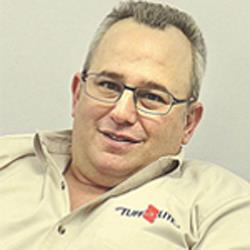


Matthew Kolmes

The "experts" range in their opinion from 60 million per year to 6 billion per year. I think that means the short answer is that no one knows the true market size.
It's definitely the medical and sportswear industries. We were taken off guard by the number of applications in the automotive industry. Seats and seat liners, replacing bulky wires in the headliners. We always think of the sportswear or casualwear applications and connecting to the IoT.
Our specialty is safety, police and motorcycle markets. We are expanding into the outdoor clothing arena, and we are doing some exciting projects for back country skiing, snowboarding and snow mobile.
We make sewing threads and yarns with highly conductive wires. We have no constraints in raw materials. We use wool from Chargeurs, and we also use cotton and polyester. We make high strength and FR smart yarns. We make yarns to our customer's specifications; so, it is really the blue sky for us.
Bio-sensing clothing, and clothing connecting to the IoT are new and rapidly expanding. In January in Japan at the 4th Wearable Tech, we saw highly developed and fully integrated products that blew us away. Heating and cooling are very important -- clothing where the fabric is a sensor and a heater.
Right now, it depends on where it is sold. Europe is so stringent where they want 50 or even 100 washings. In the US, 25 washes is considered the "life" of the garment. Right now, we have no degradation on conductivity with washing. The wear-and-tear is on the brittle connection points. We are designing new connectors for this, and partnering with companies that are developing connection techniques to improve this problem. This is the major drawback to commercialisation of products now, but, we do see ways to navigate through this. We can use laundry bags to protect the connections, or make use of "quick-disconnect" connections to remove the failure point from the garment. We could hand wash-but I don't think anyone wants to hear that, LOL.
Our CFO is not behind this question, is she? Actually, we have four full time employees that solely work on R&D and we are currently engineering one new yarn each month. The innovation pipeline is robust. I think keeping it small helps with that. We are very focused and execute R&D in short periods of time.
To be candid, it is that electronics people and textiles people do not speak the same language. Sometimes I think we are not in the same universe. The other problem I see (apart from different vocabularies) is that textiles people are used to low-priced commodity types of products. Electronics prototyping costs tens of thousands of dollars, if not hundreds of thousands. So, the hurdle is helping textile companies or clothing brands to understand exactly what they want. That is hard to do. Then you have to get them to pay for the development. This may be impossible to do. It is not in their business model.
We launched Volt in September of 2017 at the IFAI trade show in New Orleans, US. We are a brand new baby. We expect that over the next 2-3 years that Volt will become a meaningful part of our sales revenue. It is still very early and difficult to forecast. We are not quite six months old now as a brand.
We have a unique opportunity with Volt since we do not create any of the raw materials in our yarns; we have the ability to source them from companies that are responsible to the environment. For example, we work with Chargeurs and they now offer Organica, which is their new brand of wool with full transparency through the supply chain. This makes our job easier in choosing what we purchase and spec in to our smart yarns. Here at Supreme HQ, we have a green, non leaching, non heavy metal antimicrobial system where we can treat yarn and fabric without one drop of waste water going back down the drain. It is a 100 per cent closed system with zero environmental impact.
We plan to keep engineering high-tech yarns that improve peoples' lives. We have expanded our location twice in the last four years. We are building new production lines, and implementing lean lines for our garment production now. We plan to keep changing and growing! (HO)
DISCLAIMER: All views and opinions expressed in this column are solely of the interviewee, and they do not reflect in any way the opinion of technicaltextile.net.